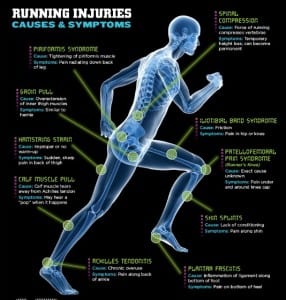 Running injuries are nearly always overuse injuries which develop over a period of time until continuing to run is no longer an option. Seeking early treatment is by far the best option in order to get back to running asap! Preventing injuries and running well over the long-term is the fastest way to become a better runner. Some injury studies put the injury rate among runners as high as 70% per year.
Running injuries are nearly always overuse injuries which develop over a period of time until continuing to run is no longer an option. Seeking early treatment is by far the best option in order to get back to running asap! Preventing injuries and running well over the long-term is the fastest way to become a better runner. Some injury studies put the injury rate among runners as high as 70% per year.
Running injuries are very specific due to the repetitive nature of the sport. Injuries are caused either by the bodies own intrinsic factors or by extrinsic factors.
The body works on a closed chain system when running i.e. when the foot is in contact with the ground, the forces and mechanics are transmitted along the leg to the spine. This is repeated every step and means if anywhere along this chain is out of line then potential injuries can happen.
Running Injury Prevention Tips
PERSONAL FITNESS:
- Prior to running, participate in a gradual conditioning program with emphasis on balancing out the strength of musculature (correct muscle imbalance). A program consisting of muscular fitness, gradual aerobic conditioning (see training / technique section), and stretching pre/post running is beneficial.
- To reduce risk of stress fractures, a slow and progressive training program that gradually increases strength and endurance of the back and lower extremities is recommended.
- Remember to warm-up and stretch at least 5 – 10 minutes before running.
- Contact a local MWR Trainer for additional information on running conditioning and correct running form. Many MWR Facilities provide safety/injury prevention information regarding preparation, conditioning, and training proper running techniques; imperfections in running style can lead to injury.
EQUIPMENT:
- Proper fitting running shoes are important; replace shoes every 6 months old .
- Orthotics may be beneficial for runners with excessive pronation.
TRAINING / TECHNIQUE:
- Correct training errors. Training should be gradually increased. For beginning runners, alternate day running is recommended. The runner should be able to talk without being short of breath. Monitor both the intensity and the duration of work-outs. Excessive distances, hill running, and speed work may cause common overuse injuries such as iliotibial band friction syndrome and shin splints. A general guideline is to increase running mileage by 10% per week. Monitor the number of days of high intensity workouts and the increase in the training programs. Alternate high effort days with low intensity days of running.
- NOTE: The body responds to excessive stress placed upon it. Even if an experienced runner attempts to increase mileage in a short time, injury may result.
- Discontinue training hard if tired. Prevent running through pain. If it takes more than 48 hours to recover, the workouts may be too long or intense.
- If racing, don’t try to make up for lost miles.
- Don’t increase mileage more than 10% a year.
ENVIRONMENT:
- Soft and flat running surfaces are recommended; avoid excessive running on cement or asphalt. Uneven ground or slanted roads should be run with caution. .Running on slanted surfaces are responsible for increased injury rates.
- Wear clothing appropriate for weather. For cold weather, dress in layers, cover both head and hands.
For hot weather, wear porous clothing. Heat acclimatization usually takes about 2 weeks.
- ACSM recommends that runs/races greater than 10 miles should not be run in temperatures over 82.4 degrees. If the temperature exceeds this, the run should be performed before 0900 or after 1600.
- Alcohol consumption should be discouraged during any athletic participation – especially running.
- Proper hydration during pre-activity and actual activity participation is recommended to prevent fatigue and heat illness. Runners should be trained to recognize early signs of heat injury.
- To run at higher altitudes, allow 3-4 weeks to acclimatize to avoid hypoxia during acute exposure.
Running Injury Prevention Conclusion
Evidence for preventive strategies to lessen running injuries is needed as these occur in 40%-50% of runners on an annual basis. Many factors influence running injuries, but strong evidence for prevention only exists for training modification primarily by reducing weekly mileage. Two anatomical factors – cavus feet and leg length inequality – demonstrate a link to injury. Weak evidence suggests that orthotics may lessen risk of stress fracture, but no clear evidence proves they will reduce the risk of those athletes with leg length inequality or cavus feet. This article reviews other potential injury variables, including strength, biomechanics, stretching, warm-up, nutrition, psychological factors, and shoes. Additional research is needed to determine whether interventions to address any of these will help prevent running injury.